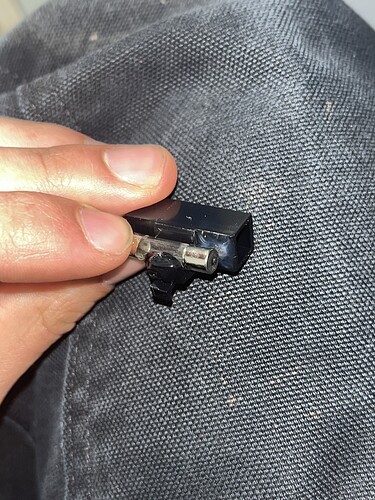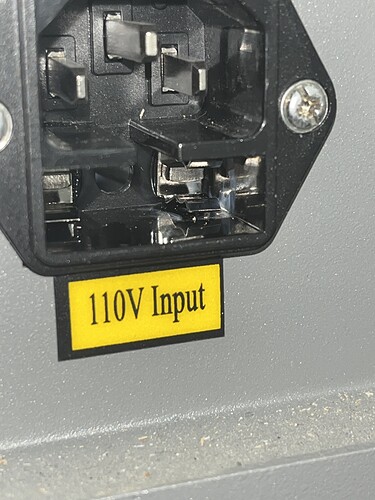I have a USB1390 cabinet laser engraver that stopped working out of nowhere. I checked the power supplies and their LED is off, and they do not get any voltage when the machine is on or when its running a job. On the controller side there is a relay “YIJIA YJ2N-GS” that has a LED indicator light that is not on. I honestly cant remember if it was ever on though. What are the next components to test?
If you’re troubleshooting, a little volt meter or MultiMeter is a great investment.
Are you saying that the HV power supply and the LV power supplies are both ‘off’? (No LEDs indicating that Line power is available to them?)
I was taught to start troubleshooting from the power supply.
Is there a fuse on the main power feed into the laser engraver?
Does the cable plug into the back of the machine and the wall outlet?
Did the cable come loose on the back of the engraver.
Did any ground wires shake loose inside the engraver.
Does the screen for the controller come on?
Here’s a picture of the power supplies, no lights, no LEDS, I checked the two AC wires on #2 with a multimeter and there was 0V. All those wires are secure, I tried pulling them out just in case they got loosened. The screen comes on, I can run a file and it’ll go through the motions but no laser fires. There’s no fuse on the back and there’s two wires that plug into the wall outlet that are plugged in and secure.
The controller (RDC6445S(EC)) has a red LED on #15 which is a ground. Could that mean there’s a grounding issue? The only ground wires I see that actually make contact with the machine are between the two plugs that go to the wall and are firmly tightened down.
I’m not very electrically savvy but I can do my best to test anything.
I think I found the cause, looks like the power was run too high and had a little fire in one of the fuses where the cords plug into the outlet and the machine.
Although the LEDs are adjacent to the terminals, what they indicate is explained in the tables on either side of the label:
- LED 15 =
+5V - LED 14 =
Run
So the controller is getting power and is producing a good +5 VDC output, which says the problem isn’t affecting the +24 V power supply feeding the controller.
The Run LED seems to be lit when the controller is running normally, whatever that means. I used to think it meant it was running a job, but that seems not to be the case.
Now that is not confidence-inspiring …
This is almost never the case…
Electrical tech tip:
The fuse (or circuit breaker) protects the conductor or wire. The conductor is sized (or oversized) for the current flow in Amperes (or in the common shorthand Amps or A).
Most ‘Low Voltage’ wiring in North America is rated for 300V or 600V. The high-voltage wire for the laser tube is usually rated around 50kV which is 50,000V. The plastic, rubber, nylon or Teflon insulation is what prevents the voltage from jumping from the conductor to the adjacent wire.
Under normal use, with correctly sized wire, everything runs fine.
If something in the circuit, ‘Fails-Closed’ it shortens the circuit. That’s what’s meant by ‘Short-Circuit’. This draws more load and if the wires aren’t protected, they can turn red-hot, or white-hot and start a fire. This is what the fuse or circuit breaker is intended to prevent.
A short circuit is often caused by two bare wires touching. I have also seen it happen when a fuse and a wire were not sized for the load, the wire can get too hot and melt the insulation enough to short out against the chassis or another wire. Components in a circuit can also short out. A badly failed power supply can fail closed and pull too much load. The fuse will be sized to protect the wire.
With the fuse you’ve shown here, I think it’s likely that you’re seeing the aftermath of a low-resistance fault that caused heating and maybe a little fire.
When the contact area of the fuse holder is incorrect, too small, a little dirty or rough, the contact area gets hot because it can’t pass the required load. The fuse and the wires can be sized correctly but a weak connection can heat up and cause the result you’re seeing.
Most importantly, don’t install a larger fuse without checking the wire size and installing larger wire if needed. If you make the fuse carry more load, you can make an undersized wire get hot before the protection kicks in. The fuse protects the conductor. I can’t emphasize this enough.
Is there a rating on the fuse?
Is there a rating on the fuse holder?
Did the fuse blow or just get hot on one end?
When I got mine, I checked the parts and what the mains current draw was.
I found the e-switch was a bit too low of a wattage value than the machine needed.
It was fine for a 240V machine, but mines on the edge. Still haven’t fixed it ![]()
![]()
Thank you for the tip! I’m still unsure what that would mean for the machine though, does that mean one of the power supplies need replacing due to a fault? And the fuse wasn’t blown, it got too hot on one end and burned a hole through the metal contact on the side, like a little pin hole. The fuse is rated for 250v and there’s two of them per wall outlet cord. I couldn’t find any rating on the fuse holder and am actually struggling to find a replacement one. Though my googling might be to blame for that. I bought new 250v fuses and plan on replacing the one that failed. I usually never run the machine over 50% since I don’t cut anything that require that power, but it was run by someone else at 90%. Is it possible that it drew too much and failed? I inspected the wiring throughout the machine and didn’t see anything apparent like burns or loose connections.
What would that do to the machine if the e stop is rated less?
The Voltage, in simplest terms, measures the amount of ‘force’ or the amount the electricity could jump. The current rating of the fuse (in Amps) is more important. It measures the amount of electricity going by.
The rating of the fuse in Amps is the critical rating. The Voltage rating of the fuse is important because the fuse has to open far enough so the electricity can’t jump the opening (if the fuse opens).
If you put in a fuse that is rated for more current (more Amps) than the wire can handle, if (when) another overload occurs, the next fire will be in the wiring.
It’s critical that you resist the temptation of installing a fuse rated for more current (Amps) than the wiring can handle. Again, I can’t emphasise this enough.
The fuse didn’t blow, so to speak. So replacing it with a higher value or amperage makes no logical sense to me.
The fuse isn’t the issue anyway, it’s the fuse holder.
This is the problem.
At lower current levels, these have virtually no resistance. Since they are near the maximum at 120V, they become resistive to the input current creating heat.
This is indicative of a cheap connector that allow you to put the fuse carrier into the machine. The fuse, being intact, and it’s carrier being melted indicates it’s at or exceeded it’s maximum rated current flow for the fuse holder (not the fuse), creating resistance and therefore heat.
The problem isn’t the fused current flow, it’s the cheap input connector on your machine that couldn’t handle the current, the fuse is fine.
No, you’re drawing most of the current just running.. There is very little current change when an lps is required to make voltage to lase. Running 50% or less will make no difference.
![]()
So I should get a better fuse carrier/plug? Will I be okay using identical fuses? They are not rated for more amperage or voltage.
It could be something as simple as the fuse holder wasn’t seated all the way and the contacts increased resistance caused it to melt.
Most of these are pretty standard made in Asia/China. This is likely what’s in there, if you want to replace it.
If you don’t just want to replace it, my suggestion would be a regular female three prong plug.
Move the fuse inside the machine. The there are plenty of types when it comes to fuse holders…
Requires you to drill a rather large hole in the chassis.
This mounts inside with a normal screw and is relatively insulated.
What do you want to do?
![]()
For now I’ll just replace what’s already there. Thank you for the links they’re very helpful, and thank you to all who helped with advice and ideas!
This topic was automatically closed 30 days after the last reply. New replies are no longer allowed.






